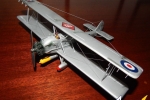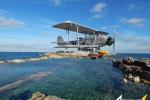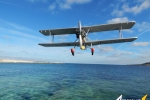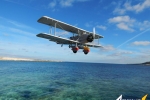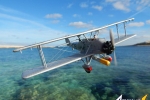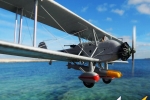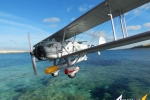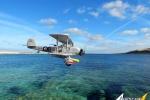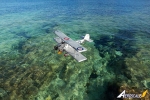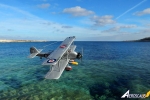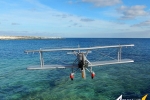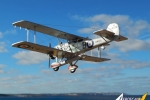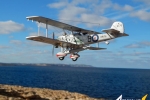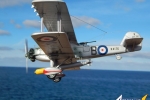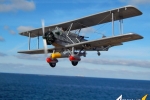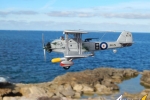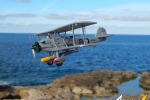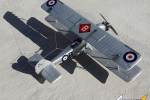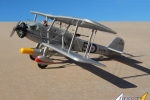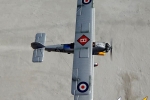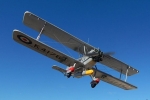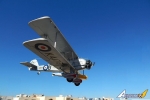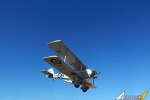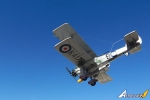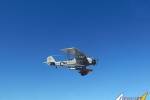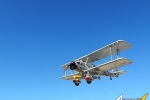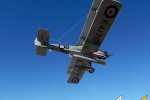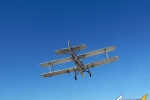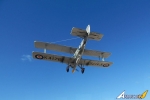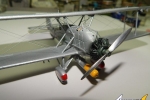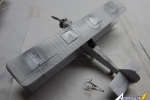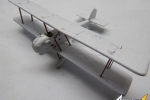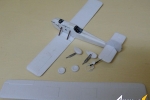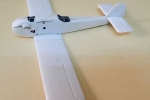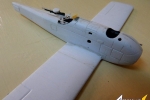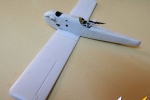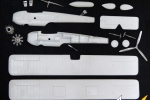1⁄72Vickers Vildebeest
4
Comments
History
The year 1935 was a year to be remembered for activities taking place at Hal-Far airfield in Malta as far as aircraft movements and activities are concerned. By February that year the activity generated at Hal Far by aircraft carriers of the Mediterranean Fleet came to a head when HMS Courageous, Furious and Eagle were all at the Grand Harbour at Valletta all at the same time. These created an unacceptable number of movements to and from the airfield.The Rear Admiral in command of the carriers, the Rt.Hon. Sir Alexander Ramsey visited Hal Far on 5th February and was apparently able to sort things out, relieving the load on Hal Far’s pressed ground crew.
The Jubilee of His Majesty Kind George V was celebrated in Malta by a review held at Marsa race course on 6th May 1935, and the Hal Far based units: 447 Flight with Fairey IIIF, 812 Squadron with Blackburn Baffin and 825 Squadron also with Fairey IIIF and Station Flight, took part. 812 Squadron excelled by carrying out illuminated night-flying, while two Avro Tutors, presumably belonging to Station Flight, performed illuminated aerobatics.
In June 1935 night time theme was continued when Hal Far aircraft took part in night exercises for the benefit of the Army searchlight operators. This activity may have taken place just at the right time. In the Autumn of that year Italy’s dictator Benito Mussolini renewed Italian attempts to conquer Abysinnia (Ethiopia) and Great Britain sent two RAF squadrons to Malta as a precautionary measure. These were 74 Squadron equipped with Hawker Demons, while 22 Squadron with Wildebeest which arrived on 10th October.
22Squadron left its UK base at Donibristle in Scotland on 3rd October1935. After passage from Glasgow on board SS Cameronia the Squadron personnel, under the command of Squadron Leader R.J.M. de St.Leger, arrived in Grand Harbour on 10th October and travelled to Hal Far.
By 22nd October the Squadron Wildebeest aircraft had been erected and tested, and the squadron was able to begin a programme of offensive training. Simulated attacks on destroyers in the Malta area formed the main part of the task, which continued, interspersed with period of work with 74 Squadron’s Hawker Demons, until the following July. On 20th July 1936 the order was received for the Wildebeest, apart from K4608, which has been destroyed in a fatal crash on 5th June, to be dismantled for the return to UK. By 25th July the aircraft had been moved to Kalafrana and before long the personnel followed, finally embarking on HMS Somersetshire on 21st August for a homeward voyage, and so ending the 11 month long connection of the Wildebeest with Hal Far airfield.
The Wildebeest was the replacement for the Hawker Horsley for Coastal Command work in the role of Torpedo bomber. First flown in April 1928 with a Jupiter VI engine. Long trials were carried out at Martelsham RAF Station. A float version was also underwent trials at Felixstowe. Cooling problems with various engines delayed trials.
Vickers built a second prototype as a private venture powered by Armstrong-Siddeley Panther II radial engine and the problem of engine cooling persisted. Installation of a Bristol Pegasus radial engine solved the cooling problem and this motor became the standard power plant for production Mk1, 2, and 3.
A float version powered by a Hispano Suiza 12-cylinder in line engine was built at the request of the Spanish Air Force. The type was eventually built under licence in Spain, 25 aircraft being built.
There were four versions of the Wildebeest. Mk1, 2 and 4 carried a crew of 2 while Mk3 carried a crew of 3. 181 Wildebeest were built while New Zealand purchased 50 Mk3s and 8 Mk4s. Another version evolved from the Wildebeest was known as Vincent. This was equipped with a belly tank for longer range and had a message pick-up hook for Army co-operation duties and also provision for carriage of personnel crew gear.
Vincents were to replace Wapitis and Fairey IIIFs in ground attack duties. A third seat position was brought into use giving the Vincent a more versatile role. 191 airframes were built or were converted from Wildebeest. New Zealand received 21 Vincents.
The kit
The kit was forwarded to me by Bill Arnold of Florida after he came to know that the Type had a good connection with pre-war aviation in Malta. Released by Contrail some 30 years ago the kit consisted of 17 vac-form parts in soft white plastic and 7 white metal parts. Three different sizes of Contrail struts also come with the kit. Any of the Mk1 to Mk4 versions could be built and there are decal markings for a MkII in Aluminium dope finish and a Vincent Mk1 in Dark green, dark earth and sky camouflage scheme. A radial cowling is also included to allow a Mk4 to be modelled and a 3 blade prop is also given for this version.Construction
Kit pack contained accurate 1/72-scale plans. This proved very useful throughout the constructon and rigging detail work. The vac parts are cut, sanded and checked for accuracy before detail is added to the interior. Fuselage side port holes are cut and shaped followed by detailing the inside compartments, that of the pilot and the rear gun operator. Good reference material is imperative for accurate detailing the kit both for the inside and outside.The fuselage halves are first detailed, cutting port windows and adding the inside compartments particularly that of the pilot and rear gunner.. Detail such as the gun mounting, step ladder, aerials on wings, aiming site in front of the cockpit, all had to be scratch built, some made from stretch sprue, others from metal wire. The detailed Pegasus engine mount, which comes in white metal, required careful trimming and cleaning and then I added other surface detail to the kit. Supply pipes and drains to wing tanks were made out of metal wire. Control lines added to elevators while rigging was added after careful study of the position of each rig line. Bomb racks added under the wings. These were left without bombs attached as it was decided that the aircraft should be armed with a torpedo.
A suitable torpedo was picked from the spares box and an array of wire attachment was built to hold the torpedo in place. The pylon wire attachment was built in such a way so that the torpedo was held in place, tilted at an angle to the floor level.
Colour and markings
The Wildebeest Mk II was completed as K4176 attached to No 36 squadron that was based at Seletar, Singapore 1936. Forward fuselage was airbrushed silver-grey dull aluminium. All other surfaces completed in silver dope. A red stripe was painted on wheel spats. Kit decals were used and in spite of their age they remained as good as new.wartime service in Malaysia
At Seletar, anti-submarine patrols were flown and a large number of torpedoes stored at Kuantan were flown back to base where the aircraft were widely dispersed. A few were damaged in air raids during January of 1942 but on the 9th the two squadrons were released for night operations, twelve from No 36 attacking Ipoh airfield. Supply drops to isolated army units were also carried out. The 25 remaining Wildebeests also carried attacks on Kuala Lumpur with sorties by No 36 while No 100 also with Wildebeests sent 11 to Quantan without loss. On 24th January, 11 Wildebeests and three Albacores destroyed the railway bridge at Labis.On 26th January, a Japanese convoy consisting of cruisers, destroyers and transports were attacked 20 miles NE of Endau as it prepared to land troops on the eastern coast of Malaya. Twelve Wildebeests were sent off in daylight in company with nine RAAF Hudsons and an escort of Hurricanes and Buffalos. Five from 100 were lost and later nine Wildebeests, three Albacores and twelve fighters were intercepted by Japanese fighters on a second strike. Five of No 36’s Wildebeests and all three Albacores being lost, which included K4176 represented by this model. Some damage to the ships was reported but the troops had already landed and nearly half of Singapore’s strike force had been lost.
On 31st January, the remaining Wildebeests were loaded with torpedos and left for Kemajoran in Java. Fifteen Wildebeests and two Albacores made the flight and on arrival they were grouped into No 36 Squadron, No 100 disbanding. By 6th March only two remained and these were given permission to fly to Sumatra where both were to be ditched and the crews would attempt to find transport to Ceylon. Unfortunately one crew was immediately captures while three of the four occupants on the second aircraft were killed during ditching.
It was the end of Wildebeests operations in South-East Asia. This had been a case of obsolete aircraft caught up in a war for which it had never been designed.
conclusion
I have a fascination to these British between wars types, and such a variety all seemed to have been deployed to Hal Far airfield at one time or other. In fact I am looking forward to make a start on a Blackburn fleet reconnaissance biplane and a Bison of Fleet Air Arm that were once frequent visitors here during the pre-war peaceful period.Comments
Hi Carmel
Excellent build as ever - and a really interesting article.
All the best
Rowan
FEB 14, 2014 - 11:35 PM
Carmel, I love your work and features! I don't know what is in the water at Malta but I'd like a big drink of it. Have you considered building a Skua?
FEB 15, 2014 - 04:52 AM
Thanks Rowan and JPTRR. You are welcome JPTRR to drink as much as you would like. Matter of fact we are in short supply of rain water but several Reverse Osmosis plants fitted here converts Mediterranean sea water into drinking water. As for the Skua I have made 2 already. All the best...Carmel
FEB 15, 2014 - 07:28 PM
Carmel,
Your work, and it's presentation continually amaze me. I'm more then impressed with anyone that can transform bits and pieces from those vacuum sheets into a perfectly built aircraft. And yet you kicked it up a few notches, and built a bi-plane and rigged it!! You weathering adds that little something to make your models that much more realistic. And then to think that all of this is in 1/72 scale. I haven't a clue as to how you managed it all.
Then you treat us with your most realistic photo presentations. I'm assuming your using Photoshop to combine more then one image. The blurred prop is a small but very important element. I also noticed that all your lighting is from above and one directional, which duplicated the sun with it's resulting shadows perfectly. Of course the spectacular water scenery and clouds just helps to create the perfect display pictures.
Joel
FEB 16, 2014 - 03:22 AM
Copyright ©2021 by Carmel John Attard. Images also by copyright holder unless otherwise noted. The views and opinions expressed herein are solely the views and opinions of the authors and/or contributors to this Web site and do not necessarily represent the views and/or opinions of AeroScale, KitMaker Network, or Silver Star Enterrpises. Images also by copyright holder unless otherwise noted. Opinions expressed are those of the author(s) and not necessarily those of AeroScale. All rights reserved. Originally published on: 2014-02-15 00:55:29. Unique Reads: 5713





